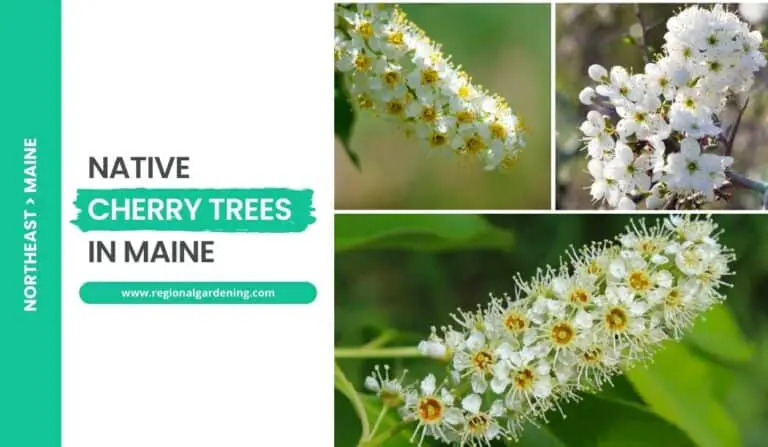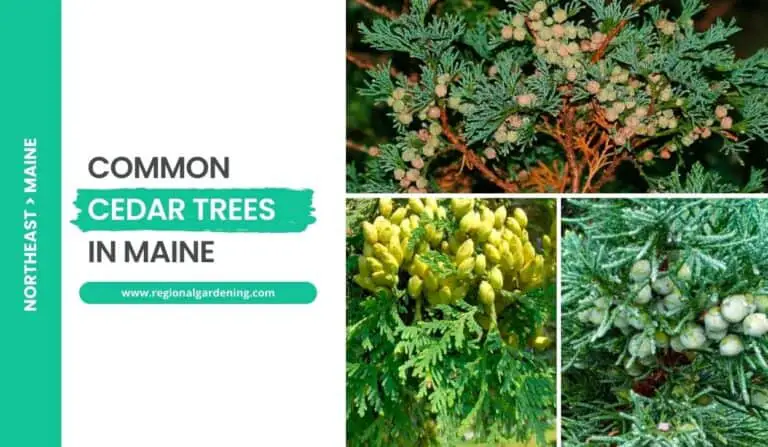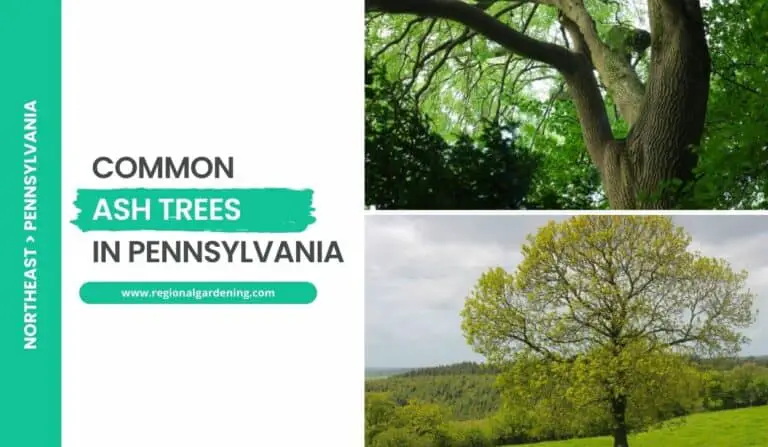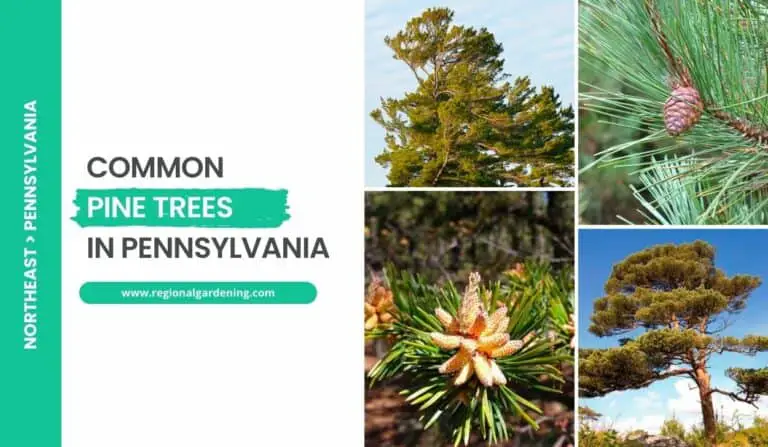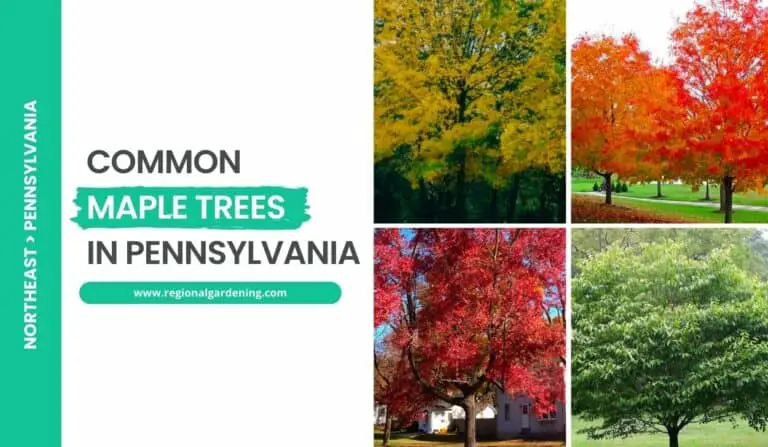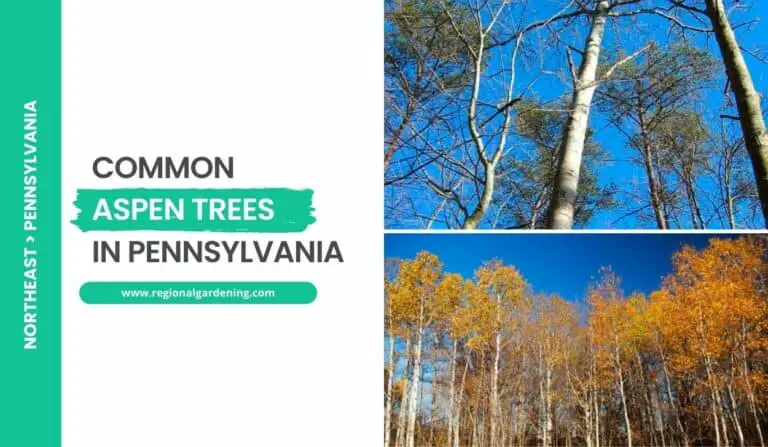7 Pink Flowering Trees In Pennsylvania (Stunning Pictures & Care)
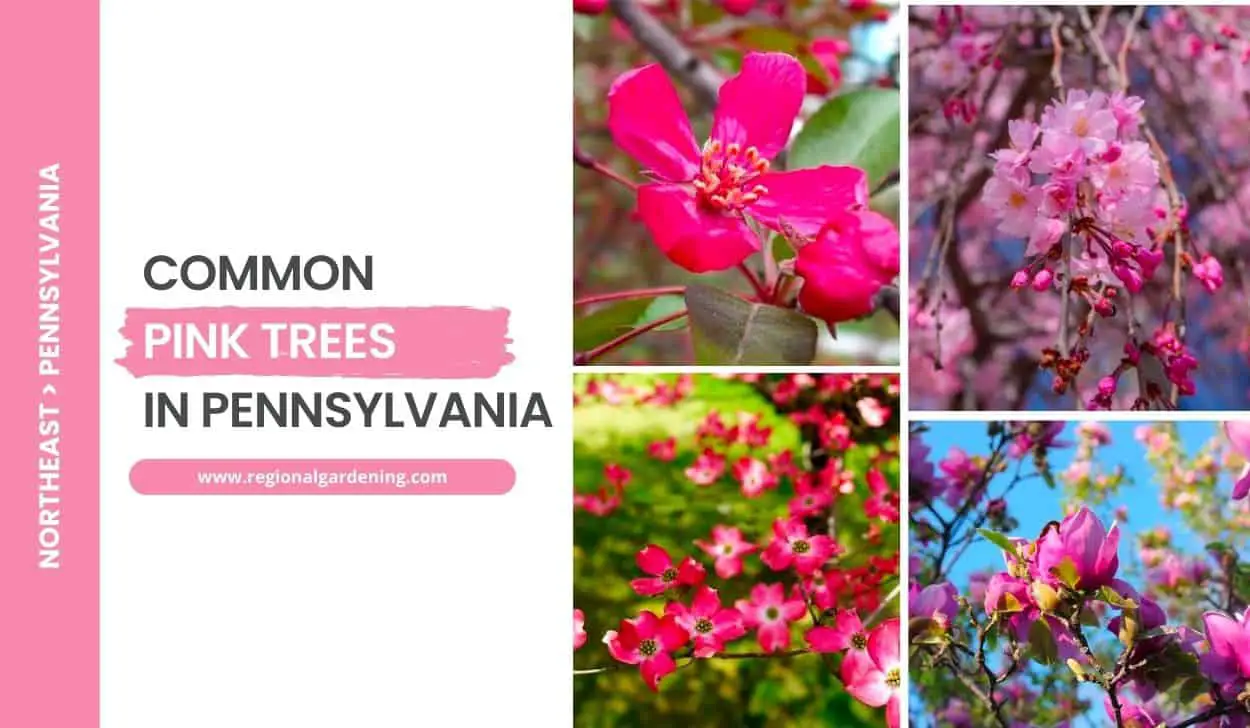
Thanks to the state’s magnificent pink flowering trees, the landscape of Pennsylvania is awash in pink tones during flowering season. In addition to adding a splash of color, these magnificent trees also foster a romantic and dreamy atmosphere.
Each pink flowering tree, from the imposing cherry blossom to the delicate Eastern redbud, has its distinct beauty and allure.
This article will talk about seven of these captivating trees, examining their unique characteristics, typical applications, and the mystic allure they bring to Pennsylvania’s great outdoors.
So, let’s start exploring the world of pink flowering trees in Pennsylvania.
1. Flowering Crabapple
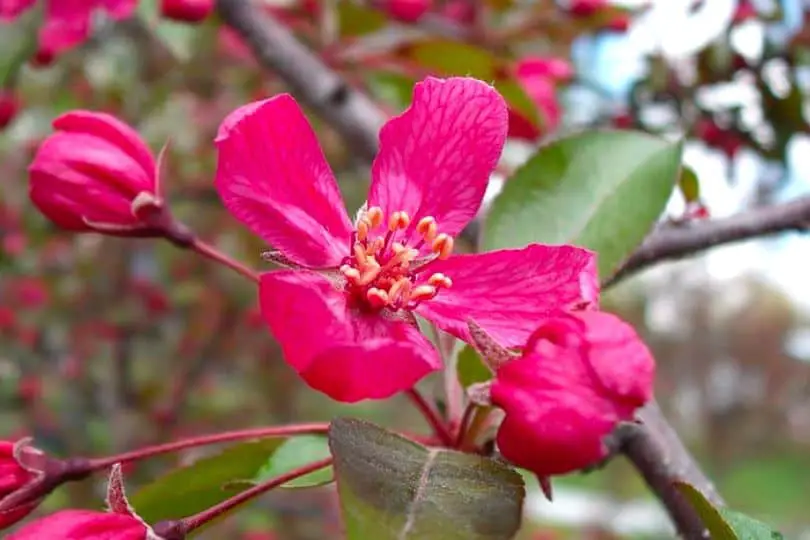
- Scientific Name: Malus spp.
- Common Name(s): Flowering Crabapple
- Mature Height: 10-25 feet (3-7.6 meters)
- Native Region: North America
- Flowers: Pink, white, or red flowers, single or double blossoms
- Fruit: Small round apples, usually red or yellow
- Uses: Ornamental tree, attracts wildlife and can be used as a windbreak or screen, and fruits can be used for making jellies or preserves
The Flowering Crabapple, formally known as Malus, is a lovely tree that may be found throughout Pennsylvania. It is well-known for its bright pink or white blooms that bloom in the spring, bringing a splash of color to the landscape. The flowers, which can be single or double, attract pollinators such as bees and butterflies. In addition, the tree produces small, spherical, tart apples that give interest to the environment.
The Flowering Crabapple normally grows to a height of 10 to 25 feet, making it an excellent choice for smaller gardens and landscapes. It has a rounded or upright shape with dense foliage that provides shade in the summer. The oval-shaped leaves have serrated edges and a glossy green tint that changes to golden, copper, or red in the fall, providing another layer of visual appeal.
The Flowering Crabapple, which is native to North America, Europe, and Asia, thrives in Pennsylvania’s climate. It favors well-drained soil and thrives in full sun to light shade, but it can survive a wide range of soil types. Regular watering is required during the establishing phase, although it is drought-tolerant once established.
The Flowering Crabapple is generally grown as an ornamental tree due to its gorgeous flowers and appealing leaves. It is frequently used to provide color and charm to landscapes and gardens. Furthermore, the tree’s little apples can attract birds, making it an excellent addition to bird-friendly environments. Some individuals like preparing jellies and preserves with apples.
Regular trimming is necessary to maintain the shape and promote new growth of a Flowering Crabapple tree in Pennsylvania. Pruning should be done in late winter or early spring before the buds break. In terms of disease and pest control, the tree may be vulnerable to problems such as apple scab and cedar-apple rust. Regular inspection and proper control methods, such as the application of fungicides as needed, can aid in the prevention and management of these issues.
2. Pink Dogwood
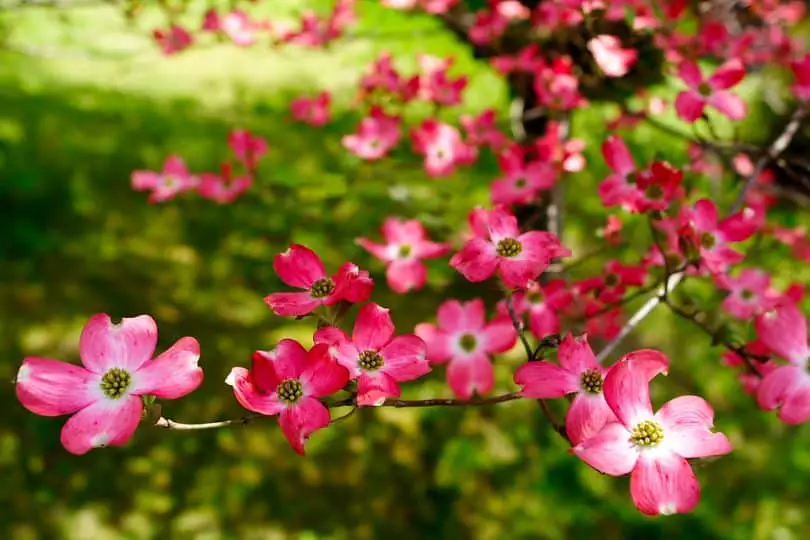
- Scientific Name: Cornus florida
- Common Name(s): Pink Dogwood
- Mature Height: 20-30 feet (6-9 meters)
- Native Region: Eastern United States
- Flowers: Pink, four-petaled flowers
- Fruit: Red, berry-like drupes
- Uses: Ornamental tree, erosion control, wildlife habitat, medicinal properties.
Pink Dogwood, also known technically as Cornus florida, is a prominent decorative tree in Pennsylvania settings. It is native to the eastern United States and grows to a mature height of 20 to 30 feet (6 to 9 meters).
This tree is well-known for its gorgeous pink blossoms, which emerge in early spring. The four-petaled blossoms cover the branches and create an eye-catching show. The tree produces red, berry-like drupes when the flowers fade, which attract birds and other wildlife.
In terms of appearance, the Pink Dogwood has horizontally spreading branches and a rounded crown. The oval-shaped leaves are dark green in hue and turn shades of scarlet and purple in the fall. As it matures, the tree’s smooth gray bark develops thin ridges.
Pink Dogwoods flourish in moderately shaded places with well-drained soil. They prefer somewhat acidic soil and require constant watering, particularly during dry spells. Mulching around the base of the tree aids in moisture retention and weed control. Pruning should be done in late winter or early spring to keep the tree’s shape and health.
Pink Dogwood has various utilitarian benefits in Pennsylvania landscapes in addition to its visual appeal. Its spreading branches give shade and aid in slope erosion management. Because its fruits provide food for birds and other species, the tree also serves as a habitat for them. Pink Dogwood bark and roots have been utilized medicinally by some Native American cultures.
3. Redbud
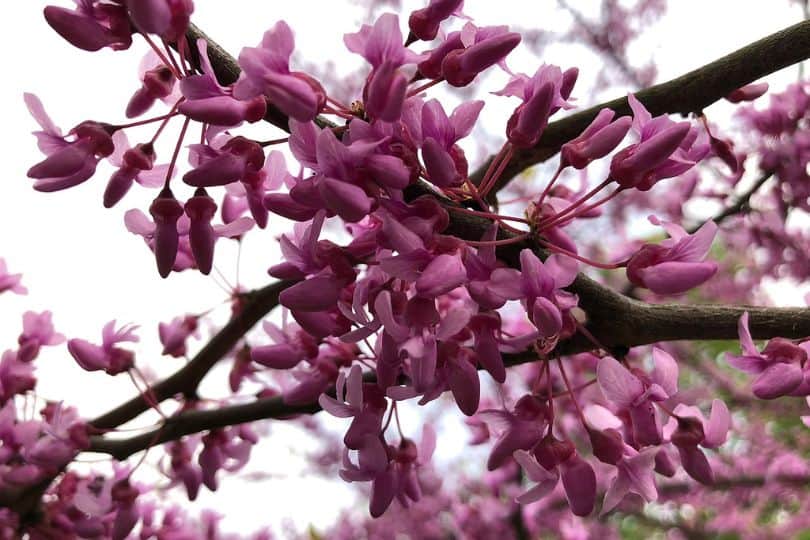
- Scientific Name: Cercis canadensis
- Common Name(s): Redbud, Eastern Redbud
- Mature Height: 20-30 feet (6-9 meters)
- Native Region: Eastern North America
- Flowers: Pink-purple pea-like flowers
- Fruit: Flat, brown pods
- Uses: Ornamental tree, attracts pollinators, provides habitat for birds and butterflies, and can be used in landscaping and as a shade tree.
The Redbud, sometimes known as the Eastern Redbud, is a common tree in Pennsylvania. It is scientifically known as Cercis canadensis and is a member of the Fabaceae pea family. This deciduous tree can grow to be 20-30 feet (6-9 meters) tall when mature. Its native range includes Eastern North America, including Pennsylvania.
The physical qualities of the Redbud are distinct. Its alternating, simple heart-shaped leaves have a silky feel and a brilliant green color that becomes golden in the fall. As it ages, the bark becomes grayish-brown and forms ridges and furrows. Early in the spring, before the leaves develop, the tree blooms with clusters of pink-purple flowers that attract pollinators such as bees and butterflies. The blossoms are followed by flat, brown pods that last throughout winter.
Redbuds grow in several soil types in Pennsylvania, including well-drained soils. They prefer full sun to partial shade and thrive in urban and suburban settings. Redbuds are low-maintenance trees, but they do need to be watered regularly, especially in their first few years. Mulching around the tree aids in moisture retention and weed control. Pruning should be done in late winter or early spring to keep the tree in good form.
The Redbud is prized for its decorative attractiveness, and its colorful flowers and vivid foliage are frequently utilized in landscaping. It can also be used as a shade tree in backyards. Redbuds also provide habitat for birds and butterflies, making them an excellent addition to wildlife gardens. Redbuds are a popular choice for Pennsylvania landscapes due to their gorgeous blossoms, low maintenance requirements, and ecological benefits.
4. Pink Magnolia
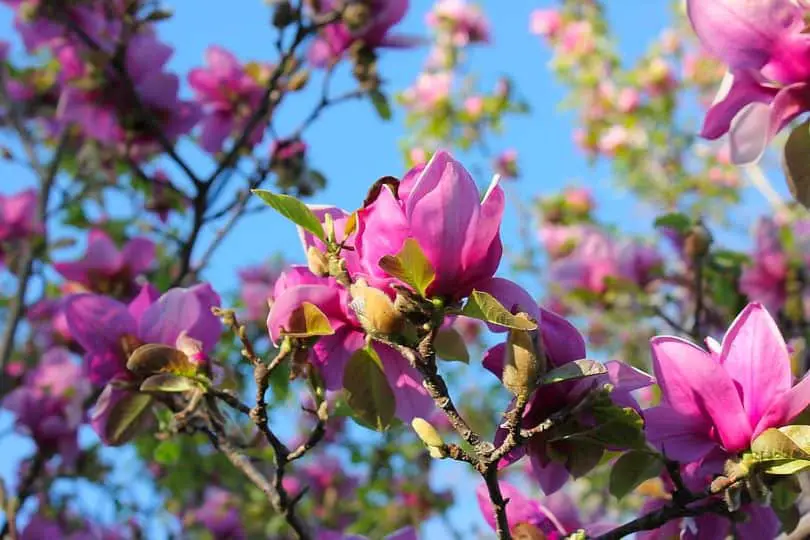
- Scientific Name: Magnolia × soulangeana
- Common Name(s): Pink Magnolia, Saucer Magnolia
- Mature Height: 20-30 feet (6-9 meters)
- Native Region: Asia
- Flowers: Large, pink, cup-shaped flowers with a white interior, appearing in early spring before the leaves.
- Fruit: Conelike aggregate of red or green fruits that develop in late summer and fall.
- Uses: Ornamental tree, provides shade, attracts pollinators.
The Pink Magnolia, botanically known as Magnolia soulangeana, is a popular ornamental tree grown for its gorgeous display of pink blooms. It is also known as the Pink Magnolia or Saucer Magnolia. This deciduous tree has a rounded shape and grows to a mature height of 20-30 feet (6-9 meters).
The Pink Magnolia, which is native to Asia, has made its way into Pennsylvania settings due to its lovely blossoms and resilience to a variety of soil types. It prefers full sun to partial shade and thrives in well-drained, wet, acidic soils. To safeguard the delicate flowers of the Pink Magnolia, put it in an area protected from strong winds in Pennsylvania.
The Pink Magnolia’s early spring blossoms, which come before the leaves, are one of its most appealing aspects. The flowers are big and cup-shaped, with colors ranging from deep pink to soft blush. Some varieties have bicolored or white interiors. These colorful blossoms attract pollinators like bees and butterflies, adding to the beauty and ecological benefit of the tree.
The Pink Magnolia also produces a conelike aggregation of red or green fruits as the seasons progress. These fruits appear in late summer and fall, providing a visually appealing feature to the tree. However, they are not commonly utilized in the kitchen.
To care for a Pink Magnolia in Pennsylvania, water it regularly during dry spells and mulch around the base to save moisture. To avoid removing next year’s flower buds, prune immediately after flowering. Regular fertilization may also be advantageous in promoting healthy growth.
Because of its stunning blossoms, the Pink Magnolia is generally employed as an ornamental tree in Pennsylvania landscaping. It is frequently planted in gardens, parks, and along streets to bring color and beauty to the environment. Its ability to provide shade and attract pollinators makes it a popular choice for landscaping work.
5. Japanese Flowering Cherry
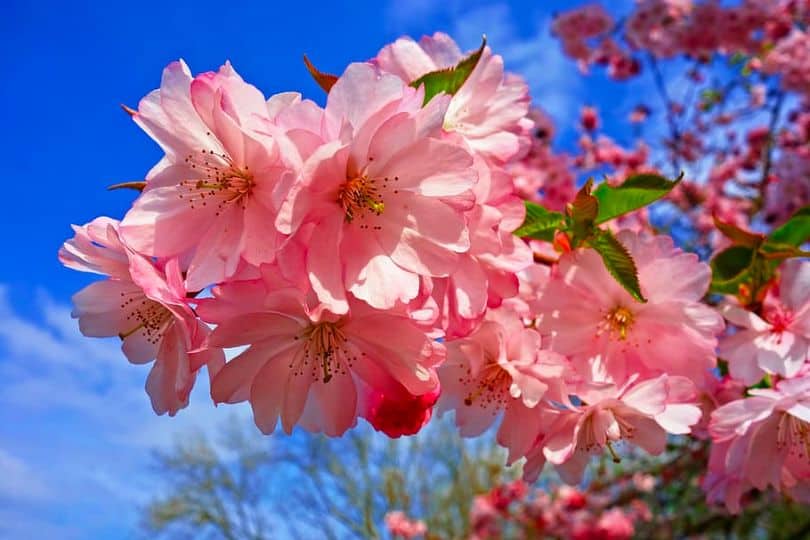
- Scientific Name: Prunus serrulata
- Common Name(s): Japanese Flowering Cherry, Yoshino Cherry
- Mature Height: 15-25 feet (4.6-7.6 meters)
- Native Region: Japan
- Flowers: The flowers of the Japanese Flowering Cherry are pale pink and single or double in form.
- Fruit: The tree produces small black fruits that are not typically edible.
- Uses: The Japanese Flowering Cherry is commonly used as an ornamental tree in landscaping and gardens due to its beautiful blooms.
The Japanese Flowering Cherry, commonly known as Prunus serrulata or Yoshino Cherry, is a Rosaceae-family deciduous tree. It is native to Japan, but due to its gorgeous springtime display of pink blooms, it has become a favorite choice for landscaping in Pennsylvania and other parts of the world.
This tree grows to a mature height of 15-25 feet, making it a good choice for modest landscapes. It has a vase-shaped spreading crown that adds elegance and beauty to any garden. The leaves of the Japanese Flowering Cherry are oval, dark green, and turn yellow before dropping in the fall. The bark is smooth and silver-gray, which contrasts nicely with the vivid pink blooms.
The Japanese Flowering Cherry requires full light and well-drained soil to thrive. It grows well in USDA hardiness zones 5-8. It can be planted in urban settings, parks, or as a focal point in household gardens in Pennsylvania. Regular watering, especially during dry seasons, is critical for the tree’s health and growth.
The Japanese Flowering Cherry’s big attraction is its lovely pink blooms, which occur in early spring before the leaves develop. Flowers that are often pale pink and fragrant. When the tree is in full bloom, it attracts pollinators such as bees and butterflies and creates a beautiful scene. Instead of edible fruit, the tree produces little black fruits that are largely aesthetic.
Because of its exquisite beauty, the Japanese Flowering Cherry is frequently utilized as an ornamental tree in gardens and landscapes. Its pink blossoms create a dreamlike ambiance, making it a popular subject for photographers and wildlife enthusiasts. The tree can be planted individually or in groups to produce a spectacular display. Its elegant branches and delicate blossoms make it an ideal choice for providing color and visual interest to any garden setting.
6. American Plum
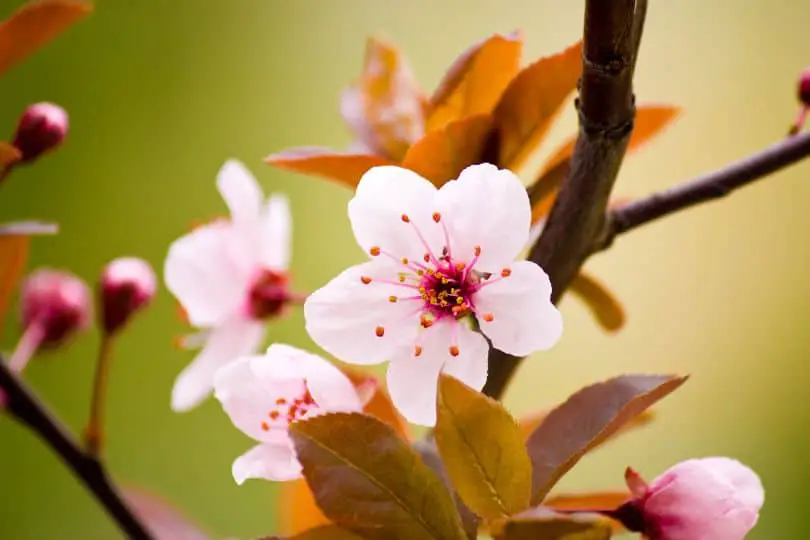
- Scientific Name: Prunus americana
- Common Name(s): American Plum
- Mature Height: 15-25 feet (4.5-7.5 meters)
- Native Region: North America
- Flowers: White, five-petaled flowers
- Fruit: Small, red or yellow plums
- Uses: Ornamental tree, wildlife food source, edible fruit production
The American Plum, Prunus americana, is a deciduous tree that grows to a mature height of 15-25 feet (4.5-7.5 meters). It is a North American native tree that can be found in many Pennsylvania environments. The American Plum is well-known for its stunning white blossoms with five petals. These flowers bloom in the early spring and offer a dash of color to the landscape.
Depending on the type, this tree yields small, round plums that might be red or yellow. The fruit has a sweet-tart flavor and is edible. American plums are also an important source of food for wildlife, drawing birds and other creatures to the garden.
The American Plum is low-maintenance in terms of upkeep. It prefers well-drained soil and full sun to partial shade. It may grow in a variety of soil types, including clay and sandy soils. It is drought-tolerant once planted and does not require regular watering. Pruning can be done in late winter or early spring to keep the shape of the tree and remove any dead or broken limbs.
The American Plum has a variety of purposes aside from its decorative value and wildlife benefits. To provide solitude and sound screening, it can be planted as a stand-alone tree or as part of a mixed-species hedgerow. Its edible fruit is used to make jams, jellies, and pies. The wood from the tree can also be used to make minor objects or as firewood.
7. Weeping Cherry
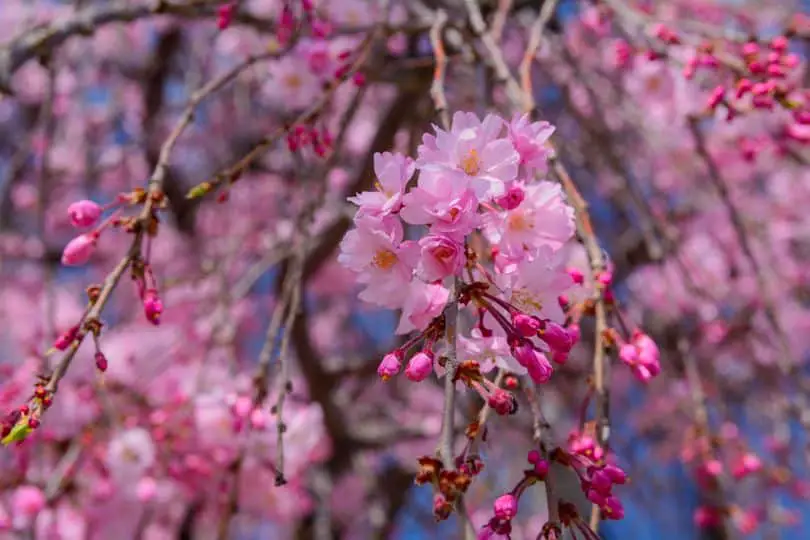
- Scientific Name: Prunus subhirtella ‘Pendula’
- Common Name(s): Weeping Cherry
- Mature Height: 20-30 feet (6-9 meters)
- Native Region: Japan
- Flowers: Pink, single or double flowers
- Fruit: Small black cherries
- Uses: Ornamental tree, shade tree, landscape focal point, attracts pollinators
The Weeping Cherry (Prunus subhirtella ‘Pendula’) is a lovely ornamental tree that will enhance any landscape. It is well-known for its weeping tendency, with branches flowing downward to create a breathtaking visual show. The mature height of the tree is 20 to 30 feet (6 to 9 meters), making it suited for modest to medium-sized gardens.
The Weeping Cherry is native to Japan and thrives in temperate areas. It prefers well-drained soil and thrives in full sun to light shade. Because this tree is sensitive to damage in exposed locations, it is crucial to pick a location in Pennsylvania landscapes that affords protection from high winds.
In the spring, the Weeping Cherry blooms profusely, providing a stunning display. Depending on the cultivar, the blossoms might be single or double. These colorful blossoms attract pollinators like bees and butterflies, increasing the biodiversity of your garden.
The Weeping Cherry yields little black cherries after the flowering season. While these cherries are not normally consumed by humans, they are an important source of food for birds and wildlife. In the fall, the tree’s green foliage turns yellow or bronze, bringing a splash of color to the environment.
Watering a Weeping Cherry tree in Pennsylvania is essential, especially during dry seasons. Mulching around the base of the tree aids in moisture retention and weed control. Pruning is required to keep the tree’s attractive shape and to eliminate dead or unhealthy limbs. Pruning should be done in late winter or early spring before new growth begins.
The Weeping Cherry is mostly utilized as an ornamental tree in Pennsylvania settings. Its graceful design and stunning blossoms make it a beautiful focal point in any garden. During the hot summer months, it provides shade, creating a cool sanctuary. Furthermore, the Weeping Cherry attracts pollinators, which helps to improve the overall health and biodiversity of the surrounding ecosystem.
Similar Articles
- Common Flowering Trees In Pennsylvania
- Common Maple Trees In Pennsylvania
- Common Cherry Trees In Pennsylvania
- Common Pine Trees In Pennsylvania
- Native Locust Trees In Pennsylvania
- Common Nut Trees In Pennsylvania
- Common Cedar Trees In Pennsylvania
- Common Palm Trees In Pennsylvania
- Common Birch Trees In Pennsylvania
- Common Aspen Trees In Pennsylvania
- Common Oak Trees In Pennsylvania
- Common Ash Trees In Pennsylvania
- Common Elm Trees In Pennsylvania
- Common Spruce Trees In Pennsylvania
- White Flowering Trees In Pennsylvania
- Purple Flowering Trees In Pennsylvania
Pink Flowering Trees In Pennsylvania – Sources
The Regional Gardening team makes sure that the information in our articles is accurate by only using sources that are known to be trustworthy. Some of these sources are peer-reviewed journals from government agencies, well-known universities, and scientific research organizations.
- Native Plant Resources, Pennsylvania Native Plant Society
- Trees & Shrubs Varieties, PennState Extension
- Landscaping With Natives, Pennsylvania Department Of Conservation, & Natural Resources.
- Explore Pennsylvania Forests, Pennsylvania Department Of Conservation, & Natural Resources.


